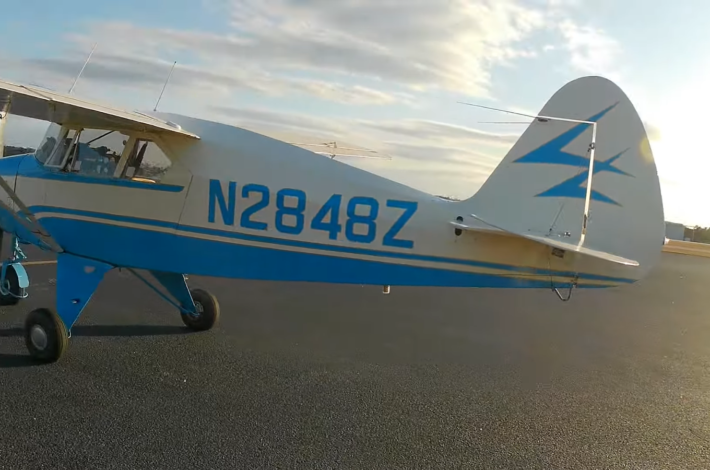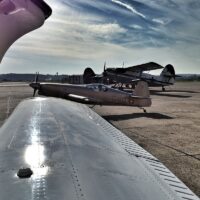
The Piper Tri-Pacer proved to be an immense success following its introduction in 1950, with sales totaling an impressive 9,490 units over a span of only 14 years. Building on the popularity of its sibling, the Piper Pa 20 Pacer, the Tri-Pacer forged its own path and attained a legendary status in the aviation world. Prior to the Tri-Pacer’s arrival, most aircraft employed a conventional tailwheel undercarriage, which demanded skill and often resulted in pilot errors and accidents during taxiing, takeoff, and landing maneuvers.
Piper introduced an innovative solution with the Tri-Pacer, featuring a tricycle undercarriage design comprising a nose wheel and two main wheels. This revolutionary approach aimed to enhance the flying experience, making it more accessible and safer for pilots. The tricycle configuration provided superior directional stability and improved visibility during taxiing, adding a sense of confidence to every flight. The Tri-Pacer’s range of higher-powered engine options, spanning from 150hp to 160hp, further contributed to its allure, delivering robust performance to pilots.
With a construction combining steel-tube and fabric, a high-wing configuration, and seating for four individuals, the Tri-Pacer boasted a spacious interior and a sturdy airframe. Its cruise speeds ranging between 105 and 110 knots showcased its capability for efficient travel. Notably, the Tri-Pacer excelled in short-field operations, aided by the inclusion of flaps, control yokes, and separate doors for passengers and pilots, exemplifying its modern and user-friendly design.
Although earlier models with lower horsepower engines faced limited range due to weight restrictions, the Tri-Pacer as a whole provided a reliable, versatile, and cost-effective aircraft that garnered immense popularity among aviation enthusiasts. Its exceptional blend of performance, adaptability, and value solidified its position as a standout choice in the aviation community, leaving a lasting legacy in the history of aircraft design.
160hp Piper Tri-Pacer Specifications
| Engines | Weights and Capacities | ||
| Model | Lycoming 0-320-B | T/O / Landing Weights Normal | 2,000 lbs |
| Cylinders | Four | Standard Empty Weight | 1,131 lbs |
| Displacement | 320 cu in | Max. Useful Load | 869 lbs |
| Horsepower | 160 | Baggage Capacity | 100 lbs |
| Aspirated | Carburettor | Oil Capacity – per engine | 8 quarts |
| TBO | 2,000 hours | Passenger Configuration | 3 |
| Crew | 1 | ||
| Propellers | |||
| Model | Sensenich 74DM6 | Aircraft Dimensions | |
| Blades | 2 | Wing Span | 29.3 ft |
| Length | 20.6 ft | ||
| Fuel | Height | 8.3 ft | |
| Octane | 100 | Wing Area | 147.5 sq ft |
| Capacity | 36 Gallons | Wing Loading | 13.5 lbs/sq ft |
| Burn @ 75% Power | 9 gph |
Piper PA-22 Tri-Pacer Pricing Guide
When considering the prices of PA-22 Tri-Pacers, it’s fascinating to delve into the historical context. The original price of a brand new Tri-Pacer in 1955 was set at US$7,295, reflecting the affordability and accessibility of this remarkable aircraft. Fast forward to today, and you’ll find a range of Tri-Pacers available on the market, each with its unique story to tell.
As with any aircraft, the condition of the individual Tri-Pacer plays a crucial role in determining its price. For those interested in lower horsepower models from the early 1950s, typically boasting a total time airframe (TTAF) of just over 3,000 hours, the typical selling price hovers around US$13,900. These Tri-Pacers retain their charm and appeal to aviation enthusiasts looking to embrace the nostalgia of the era.
On the other end of the spectrum, we have the later models that come equipped with higher horsepower engines, ranging from 150 to 160 horsepower, and approximately 3,000 hours of airframe time. These upgraded models showcase enhanced performance and are priced between US$25,000 and US$26,000. The investment in these Tri-Pacers offers a blend of modern power and reliability, capturing the hearts of pilots who seek an exhilarating flying experience.
For those who appreciate the craftsmanship of heavily modified and overhauled Tri-Pacers, the market offers a diverse range with asking prices that can range from US$30,000 to US$45,000, and in some cases, even reach close to US$60,000. These unique specimens boast personalized touches and enhancements that cater to the specific needs and desires of their previous owners.
It’s important to keep in mind that the standard airframe hours for Tri-Pacers on the market tend to fall within the range of 2,000 to 4,000 hours. These hours reflect the adventures and journeys experienced by these aircraft throughout their years of service. However, it’s crucial to consider that prices may vary based on factors such as the overall condition of the aircraft, any modifications that have been made, avionics upgrades, and the maintenance history of the specific Tri-Pacer under consideration.
Piper Tri-Pacer: Performance, Handling, and Characteristics
Pilots and owners consistently praise the Piper Tri-Pacer for its enjoyable and user-friendly flying experience. They often describe it as remarkably easy to handle, with well-balanced and light controls thanks to the rudder aileron interconnect system. Even though the Tri-Pacer can be sensitive to turbulence due to its light wing-loading, it remains relatively stable when the pilot maintains hands-on control. Stalls are gentle, with minimal nose dropping, but descent rates increase as the aircraft tends to mush down.
During flight, maintaining sufficient power during approach is crucial for a successful landing with the Tri-Pacer. Pilots share anecdotes of experiencing high sink rates when insufficient power is applied, earning the aircraft the nickname “the flying brick” in such situations. It is essential to maintain the correct approach speed and power throughout the flare to execute a smooth landing.
On the ground, the Tri-Pacer presents unique dynamics that pilots should be mindful of. Its elevated stance, narrow main gear track, and rudder pedal-controlled nose wheel via push-pull rods require delicate rudder inputs during taxiing to avoid abrupt swerves. Ground handling becomes more challenging in strong winds, requiring careful control inputs. Pilots should exercise caution during sharp or fast turns as they can be risky. Additionally, the hand-operated brakes add complexity to ground operations.
Despite these considerations, the Piper Tri-Pacer excels in short-field operations, demonstrating excellent performance with acceptable climb rates and the ability to carry substantial loads while still allowing for sufficient fuel capacity. Its versatility and capabilities make it a favored choice among pilots seeking a reliable and efficient aircraft.
160hp Piper Tri-Pacer Performance and Handling Specifications
The Piper Tri-Pacer exhibits impressive performance characteristics across various parameters. Let’s take a closer look:
| Metric | Value |
|---|---|
| Cruise Speed (Sea Level) | 109 knots |
| Cruise Speed (7,000 ft) | 116 knots |
| Stall Speed (Flaps Down) | 49 knots |
| Service Ceiling | 16,500 feet |
| Fuel Consumption (75% power) | 9 GPH |
| Best Sea-Level Rate-of-Climb | 800 fpm |
| Take-off Ground Roll | 1,120 feet |
| Max Range | 465 nautical miles |
| T/O Dist. over 50-foot obstacle | 1,600 feet |
| Landing Ground Roll | 650 feet |
| Est. Endurance (75% power) | 4 hours |
| Do Not Exceed Speed | 123 knots |
PA 22 Maintenance Schedule
When it comes to maintaining a Piper Tri-Pacer, owners can take comfort in its reasonable and hassle-free upkeep, thanks to its straightforward and robust design. Annual inspections and 100-hour maintenance checks are not only affordable but also relatively straightforward to perform. However, similar to its sibling, the Pa-20 Pacer, owners should remain vigilant about potential corrosion that may occur in the airframe tubing. Areas such as the aft fuselage longerons, tail structure, and door structure are particularly susceptible to corrosion and should be closely monitored to ensure the aircraft’s structural integrity.
It is of utmost importance for owners to stay informed and knowledgeable about AD AD 99-01-05, a directive that supersedes AD 93-10-6. This directive mandates regular inspections of the wing struts and wing strut forks to detect any signs of corrosion or cracking. Yearly strut inspections, accompanied by the application of rust inhibitors, are essential to maintain the structural integrity of the aircraft. Additionally, cracking inspections should be carried out every 500 hours. Fittings within the wing struts require replacement every 2,000 hours, and the newer fittings come with rolled threads, providing an improvement over the previous cut threads.
Another issue that some owners have encountered is slow or non-responsive cranking during the starting process, often attributed to battery cable failure. To address this concern and ensure a smoother starting experience, many owners opt to replace their cables with larger copper cables. This modification effectively resolves the issue and enhances the overall reliability of the starting system.
Enhancements and Upgrades for the Piper Tri-Pacer
The Piper Tri-Pacer provides a range of modifications and upgrades to enhance performance and address known issues. One notable option is offered by Bogart Aviation, a Washington-based company that provides a new battery box and cables to resolve slow or non-responsive cranking during starting. Additionally, under-powered generators can be replaced with alternators, offering more reliable power generation.
Brake modifications for the Tri-Pacer are widely available, with conversions from Williams and Univair being highly regarded among pilots. These STC-approved modifications introduce options such as new disc brakes, the replacement of the hand brake with toe braking, or even a combination of both.
To eliminate the need for ongoing wing strut inspections, Univair and Airframes Alaska offer lifetime sealed lift struts. This modification provides convenience and peace of mind to owners, sparing them from regular inspections. Some Tri-Pacer owners opt to re-skin their aircraft with aluminum or even convert to a conventional undercarriage configuration, similar to the Pa-20 Pacer. However, it’s important to note that the latter modification requires wing strengthening to accommodate the increased demands.
For those seeking more power, there is a modification available to replace the lower-powered Lycoming O-290 engine with the more powerful 160hp O-320. However, it is crucial to reinforce the wings to ensure they can handle the increased power output.
These modifications and upgrades offer Tri-Pacer owners the opportunity to address known issues, enhance performance, and personalize their aircraft. As always, it is important to consult with experienced professionals and adhere to applicable regulations when considering any modifications or upgrades.
Where to Source Replacement Parts for the Piper Tri-Pacer (PA-22)
You can easily find generic parts at Aircraft Spruce, Preferred Airparts, and Aircraft Supply. However, when it comes to Tri-Pacer specific parts, Univair is the name that frequently comes up. Univair, available at www.univair.com, specializes in supplying vintage aircraft parts and holds STCs for various Tri-Pacer modifications. Despite the advanced age of these aircraft, acquiring spare parts doesn’t seem to pose a problem.
Piper Tri-Pacer Common Issues
Regarding the lift-strut AD issue mentioned earlier, owners can opt for sealed struts to eliminate the need for maintenance. Extended lifespan of Ceconite, Polyfiber, or Superflight cloth used for aircraft covering can lead to airframe corrosion, making inspections more challenging.
Identifying corrosion issues can pose challenges, as certain fabrics can endure up to 20 years with proper maintenance. Some owners opt to recover their aircraft every 10 years to ensure airframe integrity and facilitate inspections, even if the fabric could last longer. Addressing battery cable and underpowered generator problems involves the installation of larger copper cables and higher power alternators, better suited for the demands of modern operations and power requirements.
PA 22 Insurance Options
Aviation insurance for PA 22 aircraft provides standard liability coverage, while hull coverage is optional. Liability coverage includes damages caused by the aircraft, including passengers, while hull coverage protects against damage to the aircraft itself. Premiums decrease with greater owner/pilot experience.
For private pilots with 500 hours of flight time and 50 hours specifically on the PA 22 model, liability coverage for US$1,000,000 costs between US$250 and US$300 annually in 2021. Less experienced pilots can expect higher premiums ranging from US$325 to US$535 per year.
Adding an additional US$25,000 hull coverage to the insurance policy, experienced pilots will pay between US$560 and US$790 per year, while less experienced pilots can expect to pay between US$760 and US$990 annually.
Piper Tri-Pacer Model Resale Value
The resale value of the Pa-22 Tri-Pacer is influenced by eight key factors related to the aircraft:
Airframe Total Hours
- Engine Hours Since Overhaul;
- Installed equipment, particularly instrument and avionic upgrades;
- Compliance with maintenance schedules;
- History of any damages;
- Condition of the fabric covering;
- Interior condition;
- History of modifications.
These factors, under the control of the owner, significantly impact the final asking price of the aircraft. The Piper Tri-Pacer has demonstrated remarkable value retention over time. In 1955, it was valued at US$7,295, and today, asking prices range from US$14,000 to US$26,000. This indicates that the aircraft has not experienced substantial depreciation over its 71-year existence.
Alongside its sibling, the Pa-20, the Tri-Pacer stands out as one of the most affordable four-seater aircraft in today’s market. It offers excellent performance on short fields, pleasant flight characteristics, satisfactory cruising speeds, and low operating costs.
Reviews
Owners of the Tri-Pacer have nothing but praise for the aircraft, as expected. They consistently highlight its minimal operating costs when well-maintained, with reported fuel consumption ranging from 7 to 9 gallons per hour depending on engine power. In comparison to a similarly aged Cessna 172, the Pa-22 offers comparable performance with lower operating costs. Owners frequently discuss the aircraft’s favorable attributes, including its smooth flight characteristics, impressive load carrying capacity, reliable short-field capabilities, and satisfactory cruise speeds.
A common consensus among owners is that the Tri-Pacer is well-suited for accommodating two people with full baggage, three people with overnight baggage, or four people with no baggage. This versatility makes it an ideal choice for various load carrying needs.
Piper Tri-Pacer Similar Aircraft
The Piper Tri-Pacer had a lineage of notable predecessors, including the Pa-15/17 Vagabond and the Piper Pa-16 Clipper. These aircraft laid the foundation for the Tri-Pacer’s success and contributed to its evolution. However, when it comes to its primary competitors, the Partenavia Fachiro, Cessna 170, and Stinson 108 emerge as strong contenders. These aircraft shared similar specifications and appealed to pilots seeking comparable features and capabilities. It’s important to mention that while these competitors had their own merits, the Tri-Pacer outshined them in terms of cruise speed. The Tri-Pacer’s superior performance in this aspect allowed pilots to enjoy faster travel and more efficient flights.
Piper Tri-Pacer Clubs You Can Join
As an owner of a Pa-22 Pacer, you have a fantastic opportunity to become part of the vibrant community of the Short Wing Piper Club. This club, accessible at https://www.shortwingpiperclub.org/, is a treasure trove of invaluable knowledge and support for its members. By joining, you gain access to a network of like-minded individuals who share your passion for Piper aircraft.
The Short Wing Piper Club boasts chapters spread across the United States and Canada, making it easy to connect with fellow owners in your region. These chapters serve as platforms for sharing experiences, organizing events, and fostering camaraderie among members. By participating in club activities and engaging with other owners, you can tap into a wealth of expertise and gain insights into the maintenance, modifications, and enjoyment of your Pa-22 Pacer.
Whether you are seeking advice on technical matters, want to discuss flying experiences, or simply want to share stories with fellow enthusiasts, the Short Wing Piper Club provides the perfect avenue for all of this and more. It’s an opportunity to enhance your ownership experience, deepen your knowledge, and forge lasting friendships with individuals who share your love for the Piper Tri-Pacer.
Conclusion
In conclusion, the Piper Tri-Pacer is a notable aircraft with a rich history and a range of impressive features. Throughout this article, we have explored its origins, specifications, and various aspects that make it a beloved choice among aviation enthusiasts. From its reliable Lycoming 0-320-B engine to its comfortable and spacious cabin, the Tri-Pacer offers a balance of performance, versatility, and comfort.
With its enduring charm and reliable performance, the Piper Tri-Pacer continues to capture the hearts of aviation enthusiasts worldwide. Whether taking to the skies for pleasure or embarking on exciting adventures, the Tri-Pacer stands as a testament to Piper’s commitment to quality and innovation.
FAQ
Service ceiling refers to the maximum altitude an aircraft can climb at a rate of no more than 100 feet per minute.
TBO stands for Time Between Overhaul, which represents the manufacturer’s recommended running time, in hours or calendar time, before an overhaul is required.
TTAF stands for Total Time Airframe, indicating the total number of flight hours the airframe has accumulated since its initial manufacture, serving as an indicator of the aircraft’s age and usage.
Aircraft Gross Weight includes the total weight of the aircraft, including pilots, passengers, fuel, oil, and cargo.
Wing loading is the ratio of an aircraft’s total mass to its wing area. Faster aircraft generally have higher wing loading due to requiring less wing area to support the same mass. However, high wing loading aircraft typically require longer distances for takeoff and landing.
A ‘rag and tube’ or fabric-covered aircraft has a fuselage constructed of steel tubes and a fabric covering that is tightened or shrunk, sealed, and painted.
Longerons are structural components in an aircraft’s fuselage that bear the load. They run longitudinally from the nose to the tail, transferring stresses and loads from the skin to the frames and formers of the fuselage structure. In wings, longerons run spanwise, from tip to root.
STC stands for Supplemental Type Certificate, which refers to an approved modification for an aircraft, engine, or component. It is considered ‘supplemental’ as it provides an approval to modify existing type-certificated items.

